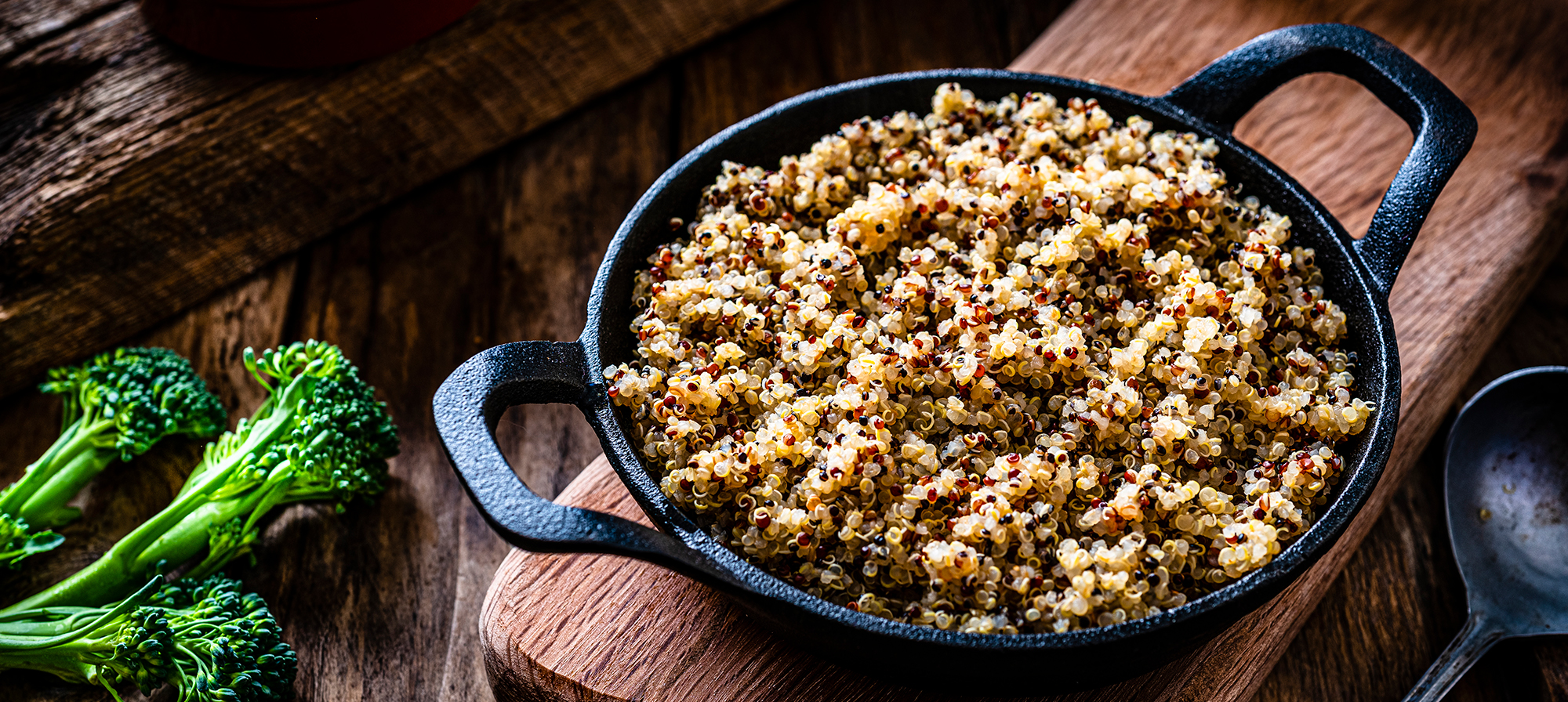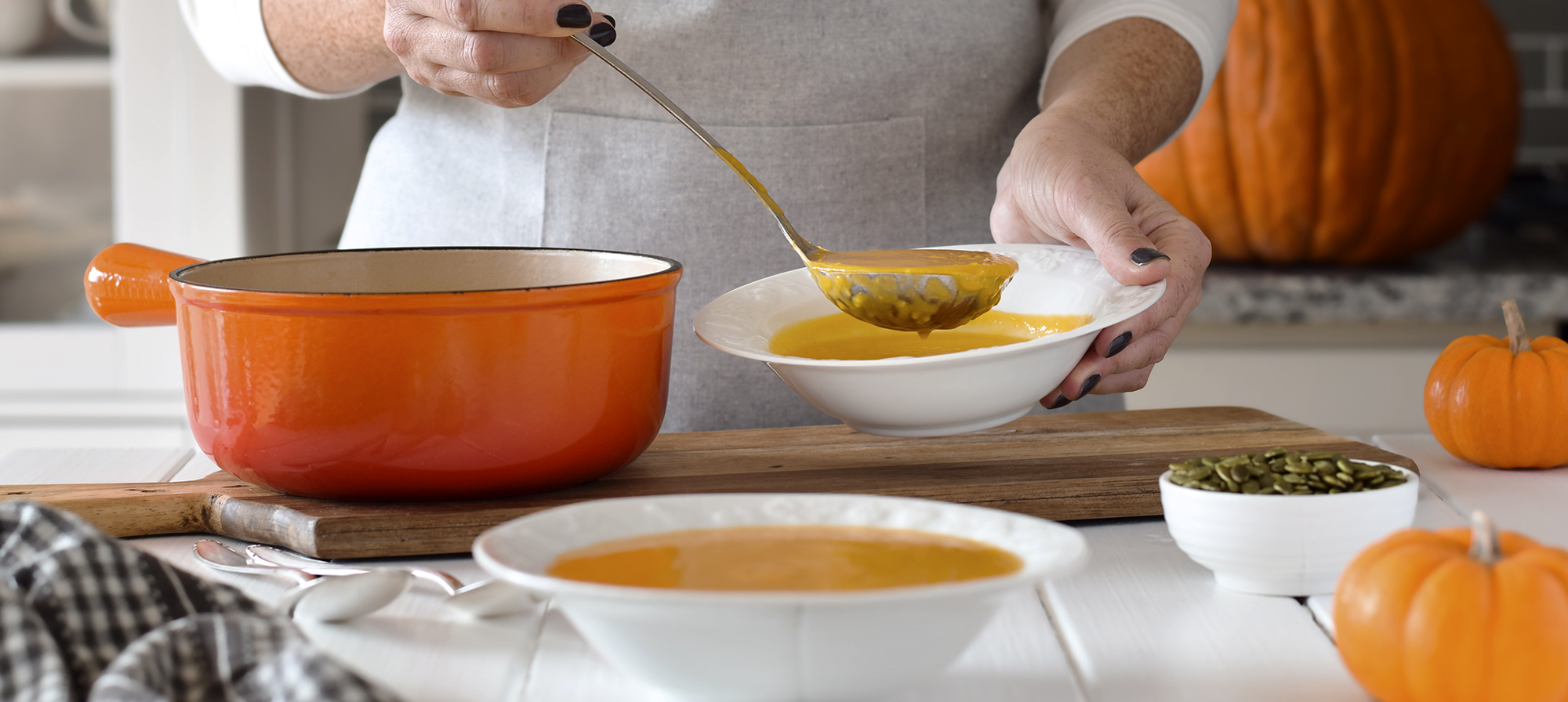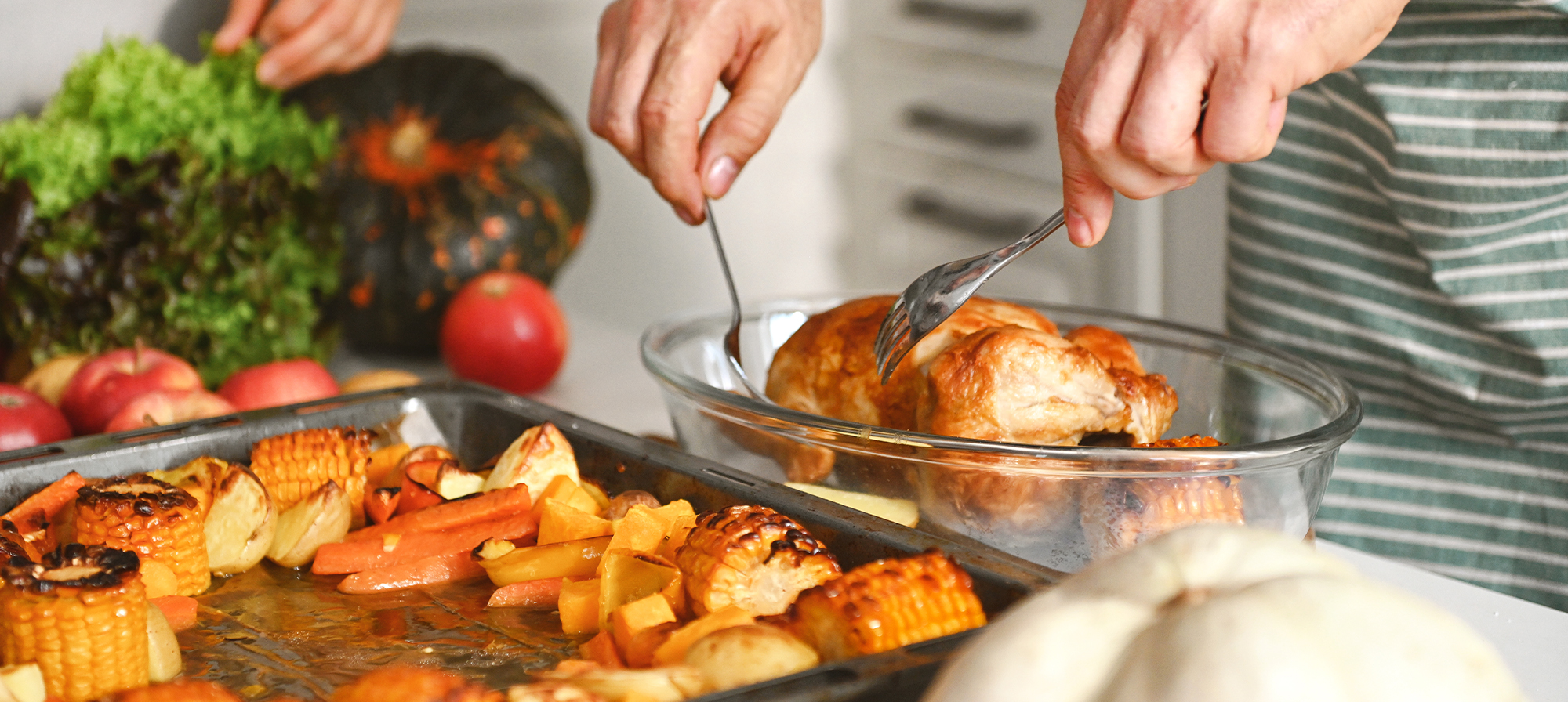Not all grains are the same. Some are so different they’re not even grains. Enter the “pseudo grains,” which are in fact seeds. But don’t think this means they’re not worthy of your food plan. Pseudo grains have very real nutritional benefits.
Pseudo grains, also known as pseudo cereals, include buckwheat, amaranth, quinoa, chia, and wild rice. While they may not be true grains, the Whole Grains Council does consider them to be “honorary grains.” There are good reasons for that.
Though they’re seeds, you prepare and eat them in much the same way as you would grains. Most seeds—like sunflower, pumpkin, or sesame seeds—are eaten raw or maybe toasted. But these seeds are steamed, boiled, or milled into a flour—just like grains. Plus, their nutritional benefits are similar to whole grains. For instance, they’re high in fiber.
But since these seeds are not actually grains, they’re also gluten-free. So, they’re a great option if you’re gluten-sensitive or have celiac disease.
You can find all 5 of these pseudo grains in most supermarkets. They’re simple to prepare, offer great nutritional value, and can help add some variety to your food plan. They also happen to be delicious.
What’s the difference between grains and pseudo grains?
Grains are sometimes thought of as the “fruits” or “berries” of various types of grasses. The most well-known grains include corn, wheat, rice, oats, rye, and barley.
Pseudo grains, on the other hand, are the seeds of broad-leafed bushes and shrubs. (Except wild rice, which is the seed of an aquatic grass.) They resemble grains, but they belong to a different family—botanically speaking.
Why does gluten-free matter?
Gluten-free foods are not necessarily any healthier than foods containing gluten. But, if you have celiac disease or if you are gluten-sensitive, it’s best to avoid eating any foods with gluten. Your body cannot process gluten, so eating it can cause painful digestive issues. This can include bloating, diarrhea, stomach pain, and other issues.
Because most breads, pastas, and crackers are made with grains or flours containing gluten, these types of foods are off-limits for those with gluten sensitivities. But pseudo grains—and the flour milled from these seeds—are gluten-free. That means products made just from these grains or their flour are good options for those who want to limit or avoid gluten.
Click here for a healthy and tasty gluten-free recipe.
But don’t think that this is the only reason to enjoy pseudo grains! Get to know these 5 pseudo grains a little better, and you’ll see what else these unique foods have to offer.
Amaranth
This pseudo grain has a long history in Mexican and Peruvian cuisine. It’s often prepared and eaten as porridge in Latin American countries. In Mexico, these tiny seeds are often prepared like popcorn and served with honey as a sweet snack called alegrίa.
Amaranth is a great source of iron. Half a cup contains more than 50 percent of the daily iron recommendation for older adults. It’s also a good source of calcium, magnesium, and fiber. And one serving of cooked amaranth has about twice the protein you’d get from rice or corn.
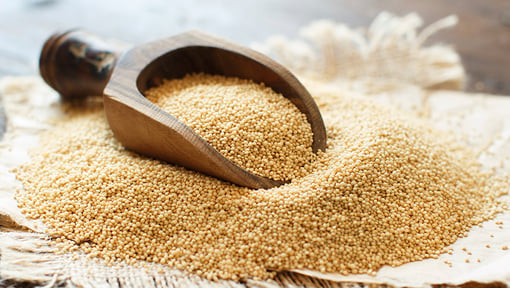
Buckwheat
Despite the word “wheat” appearing in its name, buckwheat is not related to wheat. In fact, it’s more closely related to rhubarb. Its fairly short growth period makes it a good option for farmers to grow between seasons of other crops. It is often used as a grain substitute around the world in popular traditional dishes. Buckwheat flour is used in France to make crepes, in Eastern Europe to make blini or kasha, and in Japan to make soba noodles.
Learn how to make your own delicious buckwheat pancakes at home.
A one-cup serving of cooked buckwheat is only 155 calories and contains about 5 grams of fiber, which can help you feel full longer. Buckwheat also helps support healthy cholesterol levels. That, in turn, can help protect against heart disease. And, not only is buckwheat a good source of protein; it is also a complete source of protein. That means it contains all the essential amino acids that humans cannot produce naturally and can only get from food.
Learn more about the vital jobs the 9 essential amino acids perform in your body.
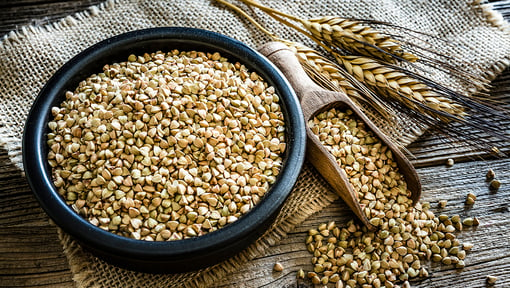
Chia
You’d be forgiven if all you know about chia seeds begins and ends with that catchy jingle from the TV ad. But chia seeds are in fact much more than simply novelty plants grown on pots in the shape of your favorite animal.
Chia seeds originated in Mexico and Central America. These mild, nutty seeds were a staple food product for ancient Aztecs and Mayans for centuries. Meaning “strength” in the ancient Mayan language, chia seeds are indeed a nutrient powerhouse.
These seeds may be tiny, but they contain all 9 essential amino acids, making them a complete protein. They’re also a good source of fiber and omega-3 fatty acids.
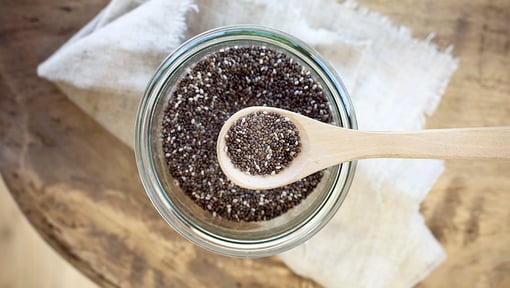
Quinoa
Quinoa (KEEN-wa) is probably one of the better-known pseudo grains. Quinoa has been a staple in South American diets for centuries. But in recent decades the popularity of this edible seed has begun to spread to the rest of the world. Due to its growth in popularity, it is more widely grown than ever and easier to find.
Quinoa also happens to be one of the more nutrient-dense foods you can find. It’s a good source of protein, manganese, magnesium, iron, vitamin B6, and more. It also contains more fiber than most grains, including brown rice. And like buckwheat and chia, it is a complete protein. It offers all of the essential amino acids humans need in their diet.
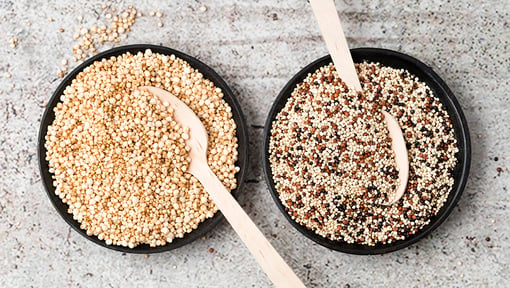
Wild rice
Although wild rice resembles rice, it is not a grain. Rather, wild rice is the edible seed of an aquatic, grass-like plant. It does look and cook like other types of rice, so that helps explain where the name came from. Wild rice was first harvested by Native Americans in the Great Lakes region. Wild rice has been a staple food of Native Americans for hundreds of years.
Wild rice is quite the nutritional powerhouse. At about 166 calories per one-cup serving, wild rice has a slightly lower calorie total than white or brown rice. Wild rice also provides more protein and fiber than most other grains. It’s also a good source of manganese, zinc, and other vital nutrients.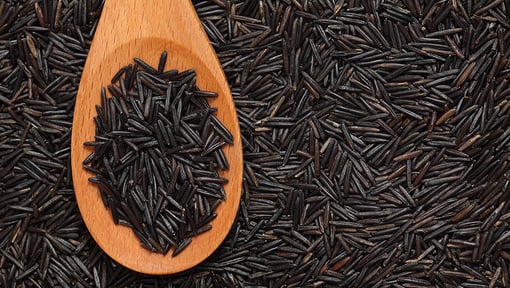
So, are you ready to try out some of these not so run-of-the-mill grains? Here’s an easy fall recipe featuring quinoa and wild rice that might just get you hooked.
Acorn Squash, Broccoli, and Grains
Ingredients
- 1 small acorn squash
- 1 tablespoon olive oil
- 2 small bunches of broccolini
- ½ cup quinoa
- ½ cup wild rice
- ½ cup red onion chopped
- ¼ cup shredded 4-cheese Italian blend
- 1 tablespoon everyday seasoning mix of your choice
- Salt and pepper (to taste)
Directions
Pre-heat oven to 350 degrees. Cut acorn squash in half and scoop out the seeds and pulp. Use a culinary brush to paint the inside of the squash with olive oil. Place squash halves facedown in a glass baking dish. Place in the oven and bake uncovered for 40 minutes or until tender and the outer skin is blistered. Remove from oven and set aside.
While squash is cooking: Steam broccolini until tender and allow to cool. Cook wild rice and quinoa according to package directions and set aside. Sauté red onion until tender in 1 tablespoon of olive oil.
Once all cooked ingredients are cooled: Peel squash and place in a medium-sized baking dish. Mash the squash with a fork into the bottom of the dish.
Chop broccolini into bite-size pieces and place in a mixing bowl. Add grains, onion, cheese, and seasoning mix. Stir until combined. Place broccolini and grains mixture on top of squash and spread to cover the squash.
Place uncovered baking dish in oven at 350 degrees for 20 minutes or until heated through and cheese is melted. Add salt and pepper to taste.
Yield: 4 servings as an entrée; 6 servings as a side dish
Prep Time: 1 hour
Cook Time: 1 hour
Difficulty: Medium
Not a Silver&Fit® member? Learn more about everything the program has to offer, including more helpful healthy living tips like this, here on our website.
This information is not intended to take the place of regular medical care or advice. Please check with your doctor before using this information or beginning any self-care program. Images used for this article do not depict any members of the Silver&Fit Program.
References
Abugoch James, L. E. (2009). Chapter 1 Quinoa (Chenopodium quinoa Willd.): Composition, chemistry, nutritional, and functional properties. Advances in Food and Nutrition Research, 58, 1–31. https://doi.org/10.1016/S1043-4526(09)58001-1
Cleveland Clinic. (2021, December 22). Amino acids. https://my.clevelandclinic.org/health/articles/22243-amino-acids
Martínez-Villaluenga, C., Peñas, E., & Hernández-Ledesma, B. (2020, March). Pseudocereal grains: Nutritional value, health benefits and current applications for the development of gluten-free foods. Food and Chemical Toxicology, 137, 111178. https://doi.org/10.1016/j.fct.2020.111178
Qiu, Y., Liu, Q., & Beta, T. (2009, July 24). Antioxidant activity of commercial wild rice and identification of flavonoid compounds in active fractions. Journal of Agricultural and Food Chemistry, 57(16), 7543-7551. https://doi.org/10.1021/jf901074b
Tang, Y., & Tsao, R. (2017, July). Phytochemicals in quinoa and amaranth grains and their antioxidant, anti-inflammatory, and potential health beneficial effects: A review. Molecular Nutrition & Food Research, 61(7). https://doi.org/10.1002/mnfr.201600767
U.S. Department of Agriculture. (2019, April, 1) FoodData Central. https://fdc.nal.usda.gov/fdc-app.html#/food-details/168897/nutrients
United States Department of Agriculture. (2019, April 1). Amaranth grain, cooked. FoodData Central. https://fdc.nal.usda.gov/fdc-app.html#/food-details/170683/nutrients
United States Department of Agriculture. (2019, April 1). Buckwheat. FoodData Central. https://fdc.nal.usda.gov/fdc-app.html#/food-details/170286/nutrients
United States Department of Agriculture. (2019, April 1). Seeds, chia seeds, dried. FoodData Central. https://fdc.nal.usda.gov/fdc-app.html#/food-details/170554/nutrients
United States Department of Agriculture. (2019, April 1). Quinoa, cooked. FoodData Central. https://fdc.nal.usda.gov/fdc-app.html#/food-details/168917/nutrients
United States Department of Agriculture. (2019, April 1). Wild rice, cooked.
United States Department of Agriculture. (2025) With alternative grains, consumers can have their cake and eat it too. https://tellus.ars.usda.gov/stories/articles/alternative-grains-consumers-can-have-their-cake-and-eat-it-too#main-content
Zhu, F. (2020, November 15). Dietary fiber polysaccharides of amaranth, buckwheat and quinoa grains: A review of chemical structure, biological functions and food uses. Carbohydrate Polymers, 248, 116819. https://doi.org/10.1016/j.carbpol.2020.116819
This article was written by Jason Nielsen, edited by Nora Byrne, and clinically reviewed by Elizabeth Thompson, MPH, RDN, on June, 4, 2025.
